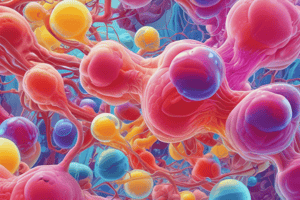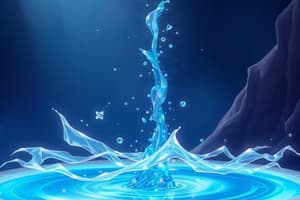Podcast
Questions and Answers
What percentage of the human body is approximately composed of water?
What percentage of the human body is approximately composed of water?
- 80%
- 50%
- 70%
- 60% (correct)
Which factors are crucial for maintaining the distribution of water throughout the body?
Which factors are crucial for maintaining the distribution of water throughout the body?
- Oxygen levels and body temperature
- Nutrient supply and moisture levels
- Electrolyte concentrations and pressure gradients (correct)
- Hormonal regulation and blood viscosity
What primarily regulates water filtration across membranes in the body?
What primarily regulates water filtration across membranes in the body?
- Electrolyte discharge
- Concentration of nutrients
- Hydrostatic pressure gradients (correct)
- Temperature differences
Which of the following statements is true regarding human blood?
Which of the following statements is true regarding human blood?
What is the significance of pressure gradients in body fluid distribution?
What is the significance of pressure gradients in body fluid distribution?
What percentage of total body water is found in the intracellular fluid compartment?
What percentage of total body water is found in the intracellular fluid compartment?
How is the extracellular fluid compartment subdivided?
How is the extracellular fluid compartment subdivided?
What is the primary function of electrolytes in the body?
What is the primary function of electrolytes in the body?
Which fluid compartment contains approximately 95% of the extravascular fluid?
Which fluid compartment contains approximately 95% of the extravascular fluid?
What methods are involved in maintaining fluid balance in the body?
What methods are involved in maintaining fluid balance in the body?
What is one consequence of electrolyte imbalance?
What is one consequence of electrolyte imbalance?
Which of the following cations is a key electrolyte in the body?
Which of the following cations is a key electrolyte in the body?
What is involved in the regulation of dehydration?
What is involved in the regulation of dehydration?
What condition is characterized by increased levels of sodium in the body?
What condition is characterized by increased levels of sodium in the body?
Which of the following can lead to hyponatremia?
Which of the following can lead to hyponatremia?
What type of ISE is suitable for undiluted samples?
What type of ISE is suitable for undiluted samples?
Which of these errors can occur with indirect ISE reading?
Which of these errors can occur with indirect ISE reading?
Which fluid imbalance can occur as a result of excessive urination?
Which fluid imbalance can occur as a result of excessive urination?
Which specimen type is NOT typically used for sodium measurement?
Which specimen type is NOT typically used for sodium measurement?
What characterizes an isotonic solution?
What characterizes an isotonic solution?
What is created by the presence of ions inside and outside of a cell?
What is created by the presence of ions inside and outside of a cell?
Which electrolyte is primarily high in intracellular fluid?
Which electrolyte is primarily high in intracellular fluid?
What can happen when extracellular fluid becomes hypertonic?
What can happen when extracellular fluid becomes hypertonic?
How can osmotic pressure be practically measured?
How can osmotic pressure be practically measured?
What causes fluid imbalance in the body?
What causes fluid imbalance in the body?
What defines a hypotonic solution?
What defines a hypotonic solution?
What is the primary purpose of determining the anion gap?
What is the primary purpose of determining the anion gap?
What does a high anion gap typically indicate?
What does a high anion gap typically indicate?
Which electrolyte has its normal range defined as 136-145 meq/L?
Which electrolyte has its normal range defined as 136-145 meq/L?
What is the normal anion gap range in mEq/L?
What is the normal anion gap range in mEq/L?
Which hormone is responsible for the reabsorption of sodium in the kidneys?
Which hormone is responsible for the reabsorption of sodium in the kidneys?
What represents a common cause of decreased anion gap?
What represents a common cause of decreased anion gap?
What is the function of sodium in the body?
What is the function of sodium in the body?
Which electrolyte is primarily involved in maintaining blood viscosity?
Which electrolyte is primarily involved in maintaining blood viscosity?
What might a low anion gap indicate if true?
What might a low anion gap indicate if true?
Which factor can lead to the temporary increase in extracellular fluid volume?
Which factor can lead to the temporary increase in extracellular fluid volume?
Flashcards are hidden until you start studying
Study Notes
Body Fluid Compartments
- The human body is approximately 60% water.
- 67% of total body water is intracellular (ICF), while 33% is extracellular (ECF).
- ECF is further divided into intravascular (25%, blood vessels & lymph) and extravascular (75%) compartments.
- Extravascular compartment includes interstitial fluid (95%) and transcellular fluid (5%).
Fluid Balance
- Maintaining water balance requires equal rates of water intake and loss.
- Intake includes eating and drinking, while excretion occurs through urine, feces, sweat, and respiration.
- Dehydration arises from excessive water loss or inadequate intake.
- Regulation of fluid balance involves thirst mechanism, electrolyte gradients, antidiuretic hormones, and renal excretion/reabsorption.
Electrolytes
- Electrolytes are charged atoms or molecules (ions) that regulate various bodily functions.
- These functions include water distribution, osmotic pressure, nerve transmission, cell permeability, oxidation-reduction reactions, and blood pH maintenance.
- Cation electrolytes include sodium (Na+) and potassium (K+).
- Anion electrolytes include chloride (Cl-) and bicarbonate (HCO3-).
Electrolyte Imbalances
- Electrolyte imbalances can be life-threatening.
- Causes include vomiting, excessive urination, sweating, diarrhea, bleeding, and exudation from burns or injuries.
Electrolyte Compartmentalization
- Each body fluid compartment contains specific electrolyte concentrations.
- Plasma and interstitial fluid are rich in sodium, chloride, and bicarbonate.
- Intracellular fluid is high in potassium.
Osmosis
- Osmosis is the diffusion of solvent molecules across a semipermeable membrane from a higher to a lower concentration.
- Osmotic pressure results from the force exerted by solute particles across the membrane.
- Higher solute concentration leads to increased osmotic pressure.
- Water movement between intracellular and extracellular compartments depends on osmotic pressure.
Anion Gap
- The anion gap is a mathematical calculation used to assess electrolyte balance and acid-base status.
- It estimates the difference between measured cations (Na+ and K+) and anions (Cl- and HCO3-).
- A normal anion gap ranges from 4 to 12 mEq/L.
Sodium (Na+)
- Sodium accounts for 90% of plasma cations.
- It enters the body through various sources (e.g., salt).
- Sodium absorption temporarily increases extracellular fluid volume.
- Sodium levels are tightly regulated within a narrow range (136-145 mEq/L).
- The Na+/K+ pump helps exchange sodium for potassium across cell membranes, maintaining a gradient.
Sodium Regulation
- Aldosterone, a hormone secreted by the adrenal gland, promotes sodium resorption and exchange with potassium.
- Atrial natriuretic peptide (ANP) is a heart hormone that increases sodium excretion and lowers blood pressure.
Sodium Functions
- Sodium plays a vital role in nerve impulse transmission, maintaining extracellular fluid osmotic pressure, facilitating muscle contractions, and maintaining acid-base balance and blood viscosity.
Sodium Imbalances
- Hyponatremia (low sodium) is more common and may be caused by low sodium intake, diarrhea, vomiting, excessive sweating, or renal disease.
- Hypernatremia (high sodium) is less frequent and can occur due to severe dehydration, Cushing Syndrome, inappropriate saline therapy, or high sodium intake with limited water consumption.
Sodium Lab Procedures
- Sodium levels are typically measured using ion-selective electrodes (ISEs).
- Direct ISEs are utilized in undiluted samples, while indirect ISEs use diluted samples.
- Specimen types for sodium measurement include serum, lithium heparinized plasma, whole blood, sweat, urine, feces, and gastrointestinal fluids.
- Errors in measurement can arise from high lipid or protein content in indirect ISEs, electrode protein coating, and competing ions.
Studying That Suits You
Use AI to generate personalized quizzes and flashcards to suit your learning preferences.




